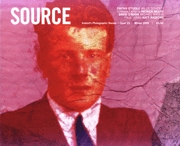Concrete Manifestations
Portadown by Victor Sloan was at The Orchard Gallery, 9 Sept - 7 Oct 2000
Review by Colin Darke
Issue 25 Winter 2000
View Contents ▸
Victor Sloan is in the unfortunate position of having produced a large body of work with which he will always be identified - his photographs of Orange and Apprentice Boy parades, worked into through scratching negatives before printing. Unfortunate because his subsequent work is always received in reference to those earlier pieces. And of course l've just done the same, but in this case I think it's unavoidable. Without the awareness of Sloan's earlier work, this show would be a tough nut to crack.
It consists of nine photographs, mostly of wall surfaces. They play quite nicely with the smooth white walls of the gallery, but as images they're fairly unremarkable. They reminded me of that first photography project (usually given the title Textures) set for new foundation students, who are thrown onto the streets with a camera and told to find interesting surfaces.
It's only when one is made aware of the political characteristics of the chosen walls that the work's significance is recognised. The identity of the images is to a large degree determined by their contextual reference. For example, the very familiar shot of an old, lichen-covered stone wall demands that we know that it is an external wall of the church at Drumcree.
This new work, then, continues to signify the northern conflict, with an eye turned to the Lodge, but now with its membership unrepresented and the damage done not to the photographs themselves, but to the objects contained within them. They have a new coolness and subtlety, which represent a maturity in Sloan's work.
The show did, however, include a video piece, which consisted of a real-time, single-camera record of speeches by Orangemen at a Drumcree rally. The stage was surrounded by slogans ('Our cause is just, our stand is honourable, our protest is dignified', etc). I defy anyone, regardless of political allegiance, to watch this monotone dirge for more than two minutes.
The nine photographs contain a narrative of sorts, following a march of their own through Portadown. The first and last contain graffiti text, identifying the two sides of the sectarian divide. The first shows a section of a perspex bus sherter, with RAT written in scratched Tipp-ex, referring to King Rat - loyalist reader Billy wright, killed by repubricans in Long Kesh. The second is an underpass, spray-painted with the name Colin Duffy, a republican twice wrongfully accused of murder, and represented by the late Rosemary Nelson.
The seven pieces sandwiched between these contain, in addition to their political characteristics, clearly definable references to twentieth-century art practice, particularly American a abstract expressionism. Whether this was intentional or not, one can identify the work of, for example, Clifford Still, Jasper Johns, Hans Hoffman and the piece showing the damaged road surface of the bridge is reminiscent of Man Ray's photograph, titled Dust Breeding, of a detail of Duchamp's Large Glass.
The works provide evidence of events in portadown in a way which, at first appearance, alienates us from the activity, but which on reflection expresses its human reality. As opposed to photojournalism, which of course searches out the sensational and provides most of us with all our visual understanding of the situation, Sloan turns his camera away from the combatants. He finds, instead, the objects they have made, their transformation of their environment through political conflict - the concrete manifestation of the clash of ideologies. Again, we see the relationship between these pieces and his earlier orange parade works. The scarring on the walls, as the scratching of the negatives, echoes the ugly and lasting results of sectarianism.
Other articles by Colin Darke:
Other articles mentioning Victor Sloan:
Other articles on photography from the 'Political' category ▸






